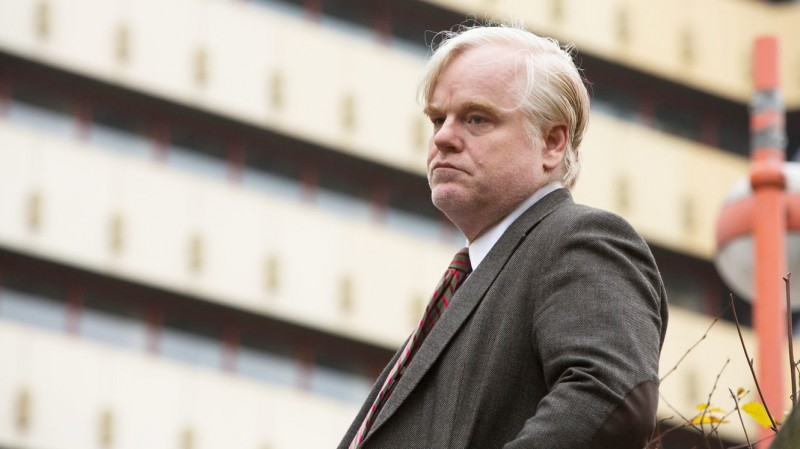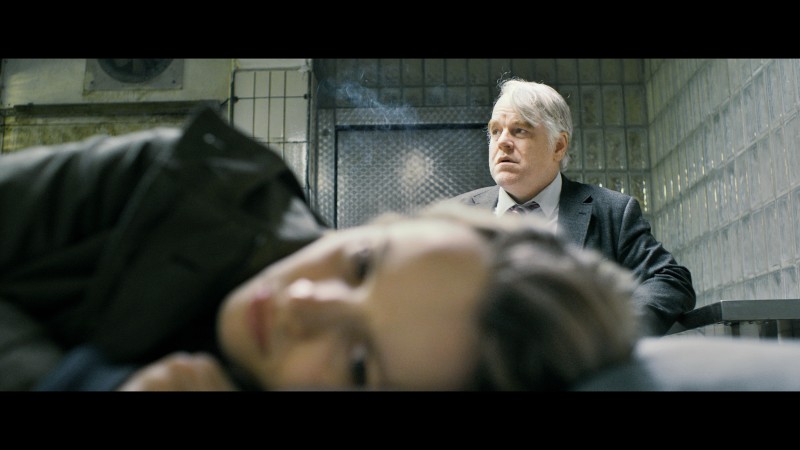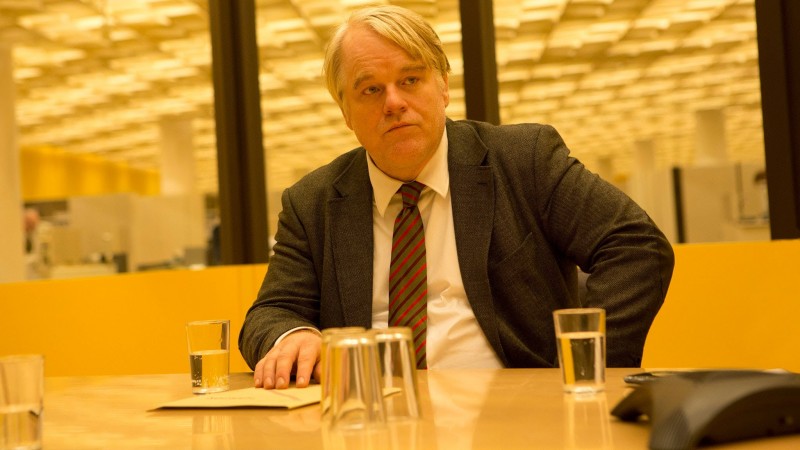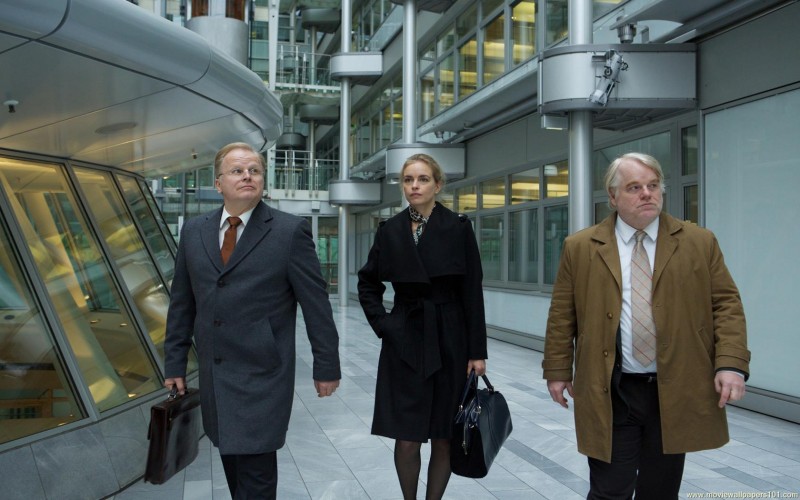A Most Wanted Man Review: Menacing and Intense, Philip Seymour Hoffman Shines
Anton Corbijn's
A Most Wanted Man is an intensely methodical spy thriller that keeps its audience uneasy and begging for more. Another in a long line of John le Carré novel-based films,
A Most Wanted Man is a worthy addition to the series.
 A Most Wanted Man
A Most Wanted Man opens on a calm Hamburg port that turns rocky with the introduction of a mysterious stranger. The film then splits its narrative in two and focuses on the brooding, Günther Bachmann (Philip Seymour Hoffman) pouring over a desk covered in photographs. Bachmann is the head of a secretive intelligence agency derived to circumvent Germany's laws in order to thwart terrorist efforts worldwide. The film then cuts back to the stranger who's activities are followed as he recites his morning prayers and heads to a train station where he innocently bumps into a stranger. This provides enough of a rotation in his body for his face to be captured on a CCTV camera. Once his face is captured on film, alarms in Bachmann's computers are sounded, and the mysterious stranger is identified as Issa Karpov, a wanted Chechen terrorist. Bachmann's team tracks down Karpov in a homeless shelter, and follows him to the home of a Turkish boxer. The film again moves back to Karpov, who, with the help of the boxer, seeks out a leftist-lawyer to help his in his cause. Annabel Richter (Rachel McAdams) is led to the boxer's home and told Karpov's story of being tortured by Russians, and forced to carry out terrorist acts. Karpov claims he is repentant of his past tribulations, and simply wants to make an honest life for himself in Germany. Karpov ends the meeting by asking Richter to seek out banker Tommy Brue (Willem Dafoe), as he will be compelled to assist. Upon the meeting with Brue, Richter discovers that Karpov's late father has an abandoned account in Brue's bank worth millions. None of these actions take place outside the watchful gaze of Bachmann's network of spies and informants. Suspect of his motives, Bachmann decides to use Karpov lure Abdullah (Homayoun Ershadi), a philanthropic Islamic Professor, into providing proof that Abdullah is secretly funding terrorist cells. Constantly working against the efforts of his own compatriots as well as that of his American counterparts, Bachmann must quickly plan and carry out an operation in order to catch his “big fish”.

In what is one of his final roles before his untimely death, Philip Seymour Hoffman offers up one of his finest performances. Playing the cigarette and alcohol-dependent spy, Hoffman is breathtakingly menacing. Full of a burning intensity, with shimmers of a lighter side, Hoffman uses his indelible talent to bring Bachmann to life. Both carrying the weight of a tormented past, Hoffman and Bachmann become one, and it is beautiful to watch. The intensity with which he smokes a cigarette, or simply takes another drink gives the audience a more effective character background than any narration could possibly suggest. Although Hoffman's performance dominates the film, his co-stars each play a vital role in the film as a whole. Playing adeptly alongside him are McAdams and Nina Hoss as Bachmann's doting assistant. Hoss does a wonderful job at contrasting her loving femininity to Hoffman's ruggedly-masculine Bachmann, which adds a sub-plot of an unspoken love between the two spies. McAdams uses her own considerable ability to portray the conflicted Richter, whose indecision between protecting a client and trusting a counter-terrorism agency is made brutally apparent in McAdams emotive portrayal.

While the acting is certainly
A Most Wanted Man's strong point, Corbijn's competent direction, and strong pacing give the story one of its best qualities. Cutting between story lines, and filling the frame with beautiful imagery give the audience plenty to contemplate throughout the film. Meticulous styling and Corbijn's unobtrusive placing of Bachmann's team throughout the film, further lend credibility to the espionage-heavy story. Every bit as brooding as its main character, the film's sullen mood provides a perfect backdrop for the narrative. Corbijn shows the audience exactly what it needs to see without convoluting the film with unnecessary dialogue, subtitling or information. The lack of superfluous elements forces the audience to contemplate the meaning of the story as well as the lives of the characters that inhabit it.

Shying away from contemporary Hollywood staples, Corbijn is able to give his audience an articulate and intelligent story without plot twists or a surprise ending; he simply tells the story. With its variety of minute details and beautiful cinematography, A Most Wanted Man is able to develop a slowly-burning narrative without losing its audience to boredom.
Pros
- Superb Acting
- Beautiful Cinematography
- Adept Direction with solid pacing
Cons
- Reminds me just how much Philip Seymour Hoffman will be missed
 A Most Wanted Man opens on a calm Hamburg port that turns rocky with the introduction of a mysterious stranger. The film then splits its narrative in two and focuses on the brooding, Günther Bachmann (Philip Seymour Hoffman) pouring over a desk covered in photographs. Bachmann is the head of a secretive intelligence agency derived to circumvent Germany's laws in order to thwart terrorist efforts worldwide. The film then cuts back to the stranger who's activities are followed as he recites his morning prayers and heads to a train station where he innocently bumps into a stranger. This provides enough of a rotation in his body for his face to be captured on a CCTV camera. Once his face is captured on film, alarms in Bachmann's computers are sounded, and the mysterious stranger is identified as Issa Karpov, a wanted Chechen terrorist. Bachmann's team tracks down Karpov in a homeless shelter, and follows him to the home of a Turkish boxer. The film again moves back to Karpov, who, with the help of the boxer, seeks out a leftist-lawyer to help his in his cause. Annabel Richter (Rachel McAdams) is led to the boxer's home and told Karpov's story of being tortured by Russians, and forced to carry out terrorist acts. Karpov claims he is repentant of his past tribulations, and simply wants to make an honest life for himself in Germany. Karpov ends the meeting by asking Richter to seek out banker Tommy Brue (Willem Dafoe), as he will be compelled to assist. Upon the meeting with Brue, Richter discovers that Karpov's late father has an abandoned account in Brue's bank worth millions. None of these actions take place outside the watchful gaze of Bachmann's network of spies and informants. Suspect of his motives, Bachmann decides to use Karpov lure Abdullah (Homayoun Ershadi), a philanthropic Islamic Professor, into providing proof that Abdullah is secretly funding terrorist cells. Constantly working against the efforts of his own compatriots as well as that of his American counterparts, Bachmann must quickly plan and carry out an operation in order to catch his “big fish”.
A Most Wanted Man opens on a calm Hamburg port that turns rocky with the introduction of a mysterious stranger. The film then splits its narrative in two and focuses on the brooding, Günther Bachmann (Philip Seymour Hoffman) pouring over a desk covered in photographs. Bachmann is the head of a secretive intelligence agency derived to circumvent Germany's laws in order to thwart terrorist efforts worldwide. The film then cuts back to the stranger who's activities are followed as he recites his morning prayers and heads to a train station where he innocently bumps into a stranger. This provides enough of a rotation in his body for his face to be captured on a CCTV camera. Once his face is captured on film, alarms in Bachmann's computers are sounded, and the mysterious stranger is identified as Issa Karpov, a wanted Chechen terrorist. Bachmann's team tracks down Karpov in a homeless shelter, and follows him to the home of a Turkish boxer. The film again moves back to Karpov, who, with the help of the boxer, seeks out a leftist-lawyer to help his in his cause. Annabel Richter (Rachel McAdams) is led to the boxer's home and told Karpov's story of being tortured by Russians, and forced to carry out terrorist acts. Karpov claims he is repentant of his past tribulations, and simply wants to make an honest life for himself in Germany. Karpov ends the meeting by asking Richter to seek out banker Tommy Brue (Willem Dafoe), as he will be compelled to assist. Upon the meeting with Brue, Richter discovers that Karpov's late father has an abandoned account in Brue's bank worth millions. None of these actions take place outside the watchful gaze of Bachmann's network of spies and informants. Suspect of his motives, Bachmann decides to use Karpov lure Abdullah (Homayoun Ershadi), a philanthropic Islamic Professor, into providing proof that Abdullah is secretly funding terrorist cells. Constantly working against the efforts of his own compatriots as well as that of his American counterparts, Bachmann must quickly plan and carry out an operation in order to catch his “big fish”.
 In what is one of his final roles before his untimely death, Philip Seymour Hoffman offers up one of his finest performances. Playing the cigarette and alcohol-dependent spy, Hoffman is breathtakingly menacing. Full of a burning intensity, with shimmers of a lighter side, Hoffman uses his indelible talent to bring Bachmann to life. Both carrying the weight of a tormented past, Hoffman and Bachmann become one, and it is beautiful to watch. The intensity with which he smokes a cigarette, or simply takes another drink gives the audience a more effective character background than any narration could possibly suggest. Although Hoffman's performance dominates the film, his co-stars each play a vital role in the film as a whole. Playing adeptly alongside him are McAdams and Nina Hoss as Bachmann's doting assistant. Hoss does a wonderful job at contrasting her loving femininity to Hoffman's ruggedly-masculine Bachmann, which adds a sub-plot of an unspoken love between the two spies. McAdams uses her own considerable ability to portray the conflicted Richter, whose indecision between protecting a client and trusting a counter-terrorism agency is made brutally apparent in McAdams emotive portrayal.
In what is one of his final roles before his untimely death, Philip Seymour Hoffman offers up one of his finest performances. Playing the cigarette and alcohol-dependent spy, Hoffman is breathtakingly menacing. Full of a burning intensity, with shimmers of a lighter side, Hoffman uses his indelible talent to bring Bachmann to life. Both carrying the weight of a tormented past, Hoffman and Bachmann become one, and it is beautiful to watch. The intensity with which he smokes a cigarette, or simply takes another drink gives the audience a more effective character background than any narration could possibly suggest. Although Hoffman's performance dominates the film, his co-stars each play a vital role in the film as a whole. Playing adeptly alongside him are McAdams and Nina Hoss as Bachmann's doting assistant. Hoss does a wonderful job at contrasting her loving femininity to Hoffman's ruggedly-masculine Bachmann, which adds a sub-plot of an unspoken love between the two spies. McAdams uses her own considerable ability to portray the conflicted Richter, whose indecision between protecting a client and trusting a counter-terrorism agency is made brutally apparent in McAdams emotive portrayal.
 While the acting is certainly A Most Wanted Man's strong point, Corbijn's competent direction, and strong pacing give the story one of its best qualities. Cutting between story lines, and filling the frame with beautiful imagery give the audience plenty to contemplate throughout the film. Meticulous styling and Corbijn's unobtrusive placing of Bachmann's team throughout the film, further lend credibility to the espionage-heavy story. Every bit as brooding as its main character, the film's sullen mood provides a perfect backdrop for the narrative. Corbijn shows the audience exactly what it needs to see without convoluting the film with unnecessary dialogue, subtitling or information. The lack of superfluous elements forces the audience to contemplate the meaning of the story as well as the lives of the characters that inhabit it.
While the acting is certainly A Most Wanted Man's strong point, Corbijn's competent direction, and strong pacing give the story one of its best qualities. Cutting between story lines, and filling the frame with beautiful imagery give the audience plenty to contemplate throughout the film. Meticulous styling and Corbijn's unobtrusive placing of Bachmann's team throughout the film, further lend credibility to the espionage-heavy story. Every bit as brooding as its main character, the film's sullen mood provides a perfect backdrop for the narrative. Corbijn shows the audience exactly what it needs to see without convoluting the film with unnecessary dialogue, subtitling or information. The lack of superfluous elements forces the audience to contemplate the meaning of the story as well as the lives of the characters that inhabit it.
 Shying away from contemporary Hollywood staples, Corbijn is able to give his audience an articulate and intelligent story without plot twists or a surprise ending; he simply tells the story. With its variety of minute details and beautiful cinematography, A Most Wanted Man is able to develop a slowly-burning narrative without losing its audience to boredom.
Shying away from contemporary Hollywood staples, Corbijn is able to give his audience an articulate and intelligent story without plot twists or a surprise ending; he simply tells the story. With its variety of minute details and beautiful cinematography, A Most Wanted Man is able to develop a slowly-burning narrative without losing its audience to boredom.